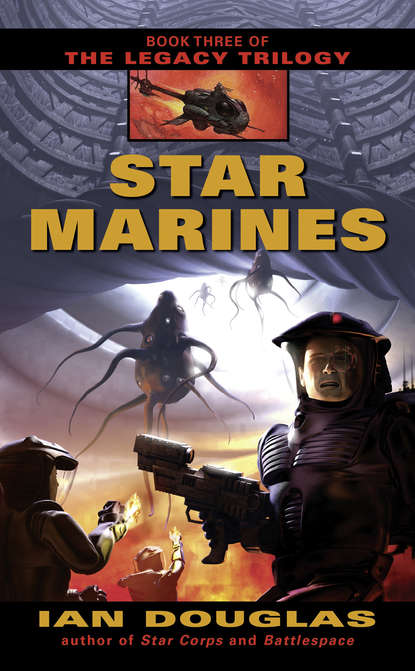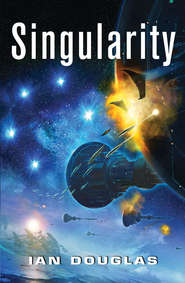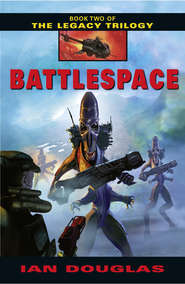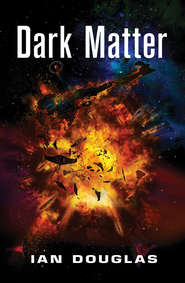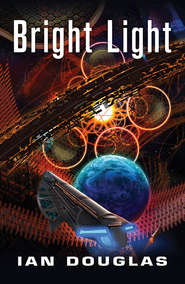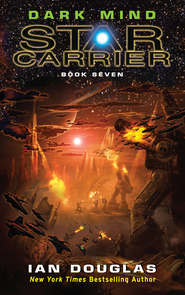По всем вопросам обращайтесь на: info@litportal.ru
(©) 2003-2025.
✖
Star Marines
Настройки чтения
Размер шрифта
Высота строк
Поля
The HELGA facility, its fire mission against the Xul ship complete, had returned to its original task—tracking and destroying each of the stream of rocks now hurtling in past the orbit of Mars, bound for Earth. Every forty-eight minutes, its recharge was complete, and Kali would loose another brief but deadly stream of invisible fire at another of the distant, fast-moving asteroids. After several shots, HELGA One came on-line as well and began adding its three-second bolts to the ongoing barrage.
HELGA One was directed by a fire-control AI named Durga, after the Hindu mother-goddess destroyer of demons. As soon as she came on-line, Durga began coordinating her fire patterns with Kali, ensuring that two bolts were not loosed toward one target when a single bolt would suffice. There were too many targets, and too little time, for duplication of effort.
Unfortunately, the radar and laser imaging scans that allowed Kali and Durga to identify and target fast-moving rocks light-minutes distant were rapidly becoming less and less reliable. Each time multimegaton bursts of energy vaporized mountain-sized chunks of rock and ice, a great deal of debris was left over, ranging in mass from dust and grains of sand to pieces the size of a large house. Each single piece had received its own new vector component when it was blasted from the parent body, causing the debris cloud to expand as it moved, but each piece also retained the original two-thousand-kilometers-per-second velocity of the original vector.
Toward Earth.
Assault Detachment Alpha
On Board the Xul Intruder
1545 hrs, GMT
The Marines of Detachment Alpha had been moving through the blast-tangled guts of the Xul ship for thirty minutes, now, exploring the nearest passageways in the glare of the lights mounted on the shoulders of their battle armor. X-ray backscatter imaging scanners had identified areas behind intact bulkheads that might be passageways and others that appeared to be packed with the Xul equivalent of electronics and heavy machinery. Nanodisassembler packs slapped against portions of the bulkhead walling off rooms or passageways had given them entrance into the bowels of the alien ship. The passageways were in vacuum—which might mean the ship’s air supply had bled away, or might simply mean the Xul didn’t need air. Researchers were still arguing over whether what humans knew as the Xul even possessed an organic component. They might well be a pure artificial intelligence—as good a term as any to apply to near-immortal beings apparently comprised of vast arrays of separate minds somehow downloaded from many sources.
It was the strangest combat Garroway had ever experienced, either in live action or in sim. The passageways, not meant for humans, were triangular in cross-section, the walls strangely folded and wrinkled, lined with almost organic-seeming masses of resin or extruded nanalloy that had a positively organic look to it. In places, the walls appeared sharp-cornered, crenellated, and neatly ordered; in others, they were lined with shapeless blocks, swellings, depressions, and bulges, often wet and oozing, with the result that moving through them felt like a nightmare journey through the intestines of some inconceivably vast beast.
The tunnels ranged anywhere from less than a meter to over six meters in height. Even in the larger corridors, the converging walls seemed tailor-made to induce feelings of claustrophobia, together with a gut-felt sense that something was simply wrong with the perspective of the place. They were not lit, not in the spectrum visible to humans, though in some the bulkheads glowed at infrared wavelengths. Backscatter examinations of the walls showed that many of the passageways, despite the fact that their interior walls were anything but smooth, were almost certainly transport tubes, which used magnetic induction coils hidden within the bulkheads to impel cargos or vehicles along their lengths at high speed.
Needless to say, the thought that an alien version of an elevator car or subway capsule might come hurtling at them out of the darkness at any moment did not at all help matters.
When Garroway led his team through a gap in the bulkhead, however, carefully picking his way past edges still glowing and dribbling off molten gobbets of hot metal from the thermal effects of the ND charge, it was not to face Xul subway vehicles, but the first onslaught of the alien vessel’s defense network.
Humans had encountered the Xul defenders before, in the battle at the Sirius Gate, and the scanty information acquired during that encounter had been endlessly studied, back-engineered, and extrapolated in sim. Like the soldiers of a terrestrial ant or termite colony—or the leucocytes in the human bloodstream—they responded to threats within the ship, appearing first in handfuls, then in greater and greater numbers. It was hypothesized that the Xul vessel was nanufacturing them somewhere in its depths, deploying them to the point of attack via the internal system of tubes and tunnels.
Garroway first became aware that the detachment was under attack when Corporal Visclosky, four behind him in the queue, screamed and his icon on Garroway’s noumenal tactical display window flashed from green to blue, then winked out. Dozens of red icons suddenly popped into existence on the same display, seeming to literally grow out of the walls on all sides.
“Man down! Man down!” Dulaney was yelling. High-speed autofire lit up the tunnel walls, casting flickering, eldritch shadows. “Shit, shit, shit! They got Visky!”
A second scream, a second light winked out. “Ortiz’s down! We lost Sergeant Ortiz!”
“Someone grab Ortiz’s boom-pack!” Garroway ordered. A brutally harsh command, but necessary. Ortiz’s telemetry showed he was dead, but the tactical nuke he’d been packing was still live and set to sequence Alpha.
It wouldn’t do to let the enemy get hold of it.
The thought elicited a derisive snort. Idiot! he thought. What would they want with it? Xul technology makes nuke-packs look like stone axes!
In the darkness ahead of him, Garroway saw movement, a flicker of black tentacles, a wink of reflected light, a shape emerging from shapelessness less than five meters away. Without thinking, he triggered his Hawking chaingun, sending a stream of 34mm slugs smashing into the half-glimpsed target. The recoil slammed him backward and tried to give him a left-to-right tumble, but his suit’s thrusters compensated automatically. He kept firing. Rounds sparked and flashed along the bulkheads with each ricochet; the shape flared white and came apart, half shattering into ragged fragments, the rest tumbling end-for-end back into the shadows.
Other targets appeared, seeming to separate from the strangely folded and crenellated walls, and he pivoted with the new motion, continuing to squeeze the firing contact inside his right gauntlet. His suit’s targeting system painted a crosshair reticule at the Hawking’s aim point, the image glowing bright in his visual field.
He could see very little of what he was fighting, even at what amounted to knife-fighting range. From intelligence gathered at Sirius Gate, he knew each Xul soldier was a teleoperated robot linked in with the ship’s controlling intelligence. Each was an elongated ovoid between a meter and two meters in length, obsidian-black, the smoothly sculpted body swollen and bulging in places, indented and concave in others, with no apparent matching of the details of its shape with others of its kind. Crystalline lenses like fist-sized rubies were set here and there in the body, again with no single design plan evident, and tentacles, as few as one and as many as twenty, sprouted from random points, helping the device to propel its way through the passageways in the zero-gravity of the Xul vessel’s interior.
Its weaponry was varied, but usually consisted of a microparticle accelerator designed to fire very tiny but very high-energy bolts of charged particles along an intense magnetic field. They also used laser technology … and in direct hand-to-hand combat, those tentacles possessed superhuman strength.
The good news was that they were not heavily armored. Even handgun fire could punch through those paper-thin shells and wreak havoc with the quantum circuitry within. The stream of 34mm slugs from the chaingun slashed through them with explosive effect, sending chunks and fragments spinning wildly through the corridor.
Garroway’s Marines had been spread out along a three-meter-wide corridor when the Xul defenders began emerging from the bulkheads, literally appearing out of nowhere right in their midst. Pivoting in mid-passageway, Garroway saw Gwyneth Istook struggling in the grasp of a forest of black tentacles that seemed to grow from the nearest of the three enclosing walls.
Sending a stream of chaingun fire down that passageway would kill more of his Marines than Xul robots, despite the weapon’s safety-interrupt; he mentally thumbed his weapon selection to CQC and fired.
Close-Quarters Combat called for a change in ammo as well as a change in tactics. The mental selector switched his Hawking loadout to SX, low-velocity safety-explosive rounds that detonated on impact and would neither ricochet off the walls nor pass through the target to kill someone in the line of fire beyond. It also switched his fire selector to single-shot. He raised his right arm, dragging the reticule in his visual field onto the black mass entangling Istook, and squeezed the firing switch. Nothing happened; Istook’s struggles had pulled her around until her suit entered Garroway’s line of fire, and the safety-interrupt in his combat computer had blocked the shot. Cursing under his breath, Garroway shifted his aim into the shadowy mass farther from the jerking form of Ishtook’s CAS and fired three quick-spaced rounds. Tentacles whiplashed, then came apart. Ishtook tumbled backward out of the thing’s grasp, bouncing hard off the opposite bulkhead. “Th-thanks, Gunny!”
“Not a problem,” he said, snagging the arm of her suit and stopping her rebound. “Stay close!”
“Gunny! The black-hats are on the run!”
It was true. The attackers were vanishing from the tactical display—destroyed, or retreating back into countless small, hidden side passages.
“Section! Who has Oritz’s boom-pack?”
“Right here, Gunny,” Corporal Hood called.
“Give it here.” They needed to plant these last two charges, then get the hell out of Dodge. “C’mon! In here!”
His suit lights had revealed a side passageway leading off at an odd angle from the main one. Ducking inside, they found themselves in a small, elongated room with gtextening walls. “Place your weapon there,” he told her, pointing. He watched her back as she set her K-94 against one wall and release the nanoseal in its base, anchoring it solidly in place. “Set sequence Bravo.”
Вы ознакомились с фрагментом книги.
Приобретайте полный текст книги у нашего партнера:
Приобретайте полный текст книги у нашего партнера:





